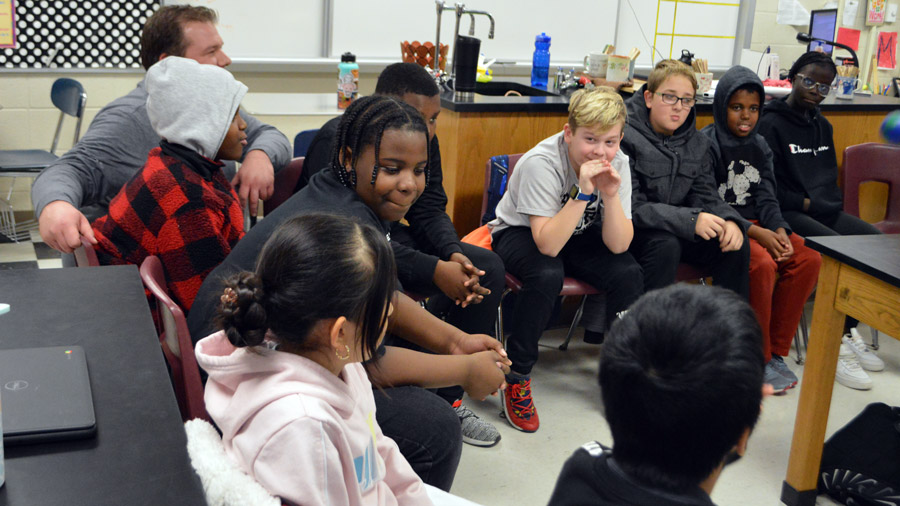Multi Districts — Educators know students’ needs include strong instruction and curriculum that addresses gaps exacerbated during the pandemic: tutoring, paraprofessionals and social-emotional care.
Thanks to federal Elementary and Secondary School Emergency Relief Fund dollars, districts now have money to meet those needs. But hiring enough staff members to do so continues to be a problem.

“The word that comes to mind is frustrating,” said Wyoming Public Schools Superintendent Craig Hoekstra. “Now we have dollars for areas we know we need to increase support in, but the frustrating part is you don’t see the things you’d like to see coming to fruition because you don’t have the people to hire to spend that money on … The needs of the students are not going away.”
The situation — which is impacting districts nationwide — is a shift from pre-pandemic years when district leaders constantly needed to advocate for funding increases because there wasn’t enough money to adequately cover costs or address inequities. “The problem is still there but the ‘why’ has shifted,” Hoekstra said.
Superintendents from Kent, Ottawa and Muskegon counties signed a letter to the Michigan congressional delegation requesting Congress support for a deadline extension to December 2026 for using ESSR funds.
That would give the district leaders more time to spend funds — and spread out spending – from three different ESSR allocations. Part of the 2021 Coronavirus Response and Relief Supplemental Appropriations Act, the districts were given staggered deadlines to spend the money — which totalled $264.15 million across Kent County’s 20 school districts. The Sept. 30, 2022 deadline for ESSR I already passed. Remaining deadlines — if not extended — are Sept. 30, 2023 for ESSR II and Sept. 30, 2024 for ESSR III, the largest allotment.
‘We know the needs and we need to be able to address them in a fiscally responsible way and with great intention.’
— Wyoming Public Schools Superintendent Craig Hoekstra
The difficulty in spending the money is mostly in the area of staffing, Hoekstra said. The district has posted job openings for the 2023-2024 school year, including several teachers, two social workers, a counselor and a school psychologist.
But the pool of teachers in the workforce has shrunk, meaning it’s common to receive about a third of the applicants for jobs that years ago received upwards of 100. Psychologists, counselors and social workers are extremely hard to find, he said. Another question is how to maintain positions after funding is spent.
“If dollars can be extended we can extend support and plan for what we know we need in the future,” he said. “We know the needs, and we need to be able to address them in a fiscally responsible way and with great intention.”

In Kentwood Public Schools, much of what’s needed requires social workers, counselors, tutors, interventionists and nurses. “We know that the recovery process from COVID will be for an extended period of time, with or without the funds,” said Kentwood Public Schools Superintendent Kevin Polston. “A lot of the folks that are in high demand are in low supply.”
The district is implementing a high-dosage tutoring program at Townline Elementary School, which Polston would like to see started on a broader scale districtwide. (More than a dozen third graders receive 15 minutes of tutoring focused on reading fluency each day.) “We haven’t been able to get the people to do that,” he said.
Extending the deadline would allow more time for the job market to open up and for districts to pump resources into educator pipeline development, he said.
“We have a priority list of ways to support our students using federal funds, but our highest priority is their academics and social emotional well-being,” Polston said.

More Time Needed to Spend Funds
Districts receiving the most ESSR funds were Grand Rapids Public Schools at $115 million, Kentwood Public Schools at $24.3 million, and Wyoming Public Schools at $12 million. Funding was determined mostly based on Title I formulas, which provide funds for low-income schools. Those formulas provided wide swings in ESSR funding for Kent County schools.
‘It’s almost three times the size of ESSR II, at least in our county. That’s just so much money to try and spend.’
— Kent ISD Assistant Superintendent Kevin Philipps

Districts have spent all of ESSR I funds, which was considered “triage” funding to respond to immediate pandemic-related needs including pivoting to virtual learning, said Kevin Philipps, Kent ISD assistant superintendent of administrative services.
ESSR II and III are largely going toward personnel costs for new positions such as mental health professionals and staff needed for programs to address interrupted learning, he said.
The deadline to spend ESSR III funds in time — GRPS’ third allotment alone was $74 million — is proving tricky.
“It’s almost three times the size of ESSR II, at least in our county. That’s just so much money to try and spend,” Phillips said. “Obviously, with the labor shortage, it’s been a struggle to find the individuals that you would want to do some of the work you want to address.
“As we know, not only is there a growing teacher shortage, but even worse is trying to find some of the itinerant types of employees: social workers, counselors, nurses, some of the things you really need. It’s hard to find those resources. It’s even probably hard to find those resources on a contracted level.”

Districts have already been given some flexibility on construction projects funded through ESSR, Philipps said. Some districts, because their allocations were so large, wanted to provide better learning environments via upgraded HVAC systems. But backlogs in construction delayed projects.
A related challenge for districts is that they are facing the unique challenge of having different pots of money intended for the same use. The State of Michigan has continued to earmark money for specific areas, like mental health services, for example — that districts could use ESSR funding to pay for.
Chris Glass, Kent ISD assistant superintendent of Legislative & Organizational Initiatives, recently presented testimony in Lansing on the issue to the Appropriations Subcommittee Pre-K-12. He asked the state to avoid duplication of funding programs already supported by ESSR federal funds.









